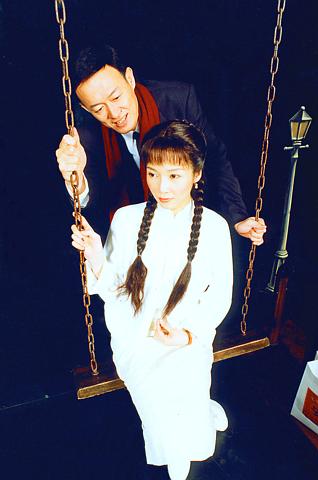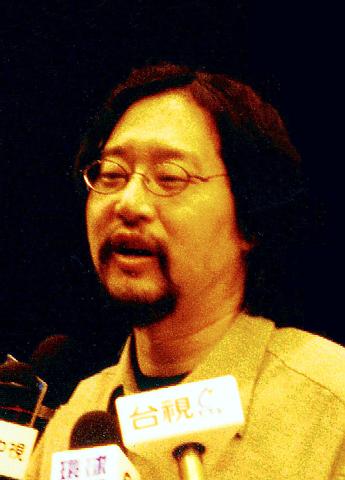Fifteen years after its conception, Performance Workshop Theater's The Peach Blossom Land is back on the stage and seemingly more relevant than ever.
The work, which debuted in 1986 -- at a time when China and Taiwan were making their first tentative steps towards dialog -- created a sensation for the boldness of its conception as well as its technical excellence.
Performance Workshop Theater and its members have since gone on to further artistic achievements in theater, film and television, but The Peach Blossom Land has continued to grow in stature and has become a classic of Taiwan theater.

PHOTO COURTESY OF PERFORMANCE WORKSHOP THEATER
In 1991, when the show was taken on tour in the US, Newsweek trumpeted The Peach Blossom Land as "the most recent piece of evidence that Taiwan is creating the boldest Chinese art in Asia today."
The core of the play is a short story by the poet Tao Yuan-ming (AD 365-427) called The Peach Blossom Land -- the Chinese Utopia. This essay is familiar to almost every Chinese child, and many people, regardless of literary pretensions, can quote from it.
The story tells of a fisherman who one day travels farther along the river than usual and suddenly finds himself in a land filled with peach blossoms.

PHOTO: IAN BATHOLOMEW
Here, people live untroubled by the outside world, ignorant of violence and war, in a idealized pastoral environment.
The fisherman stays with them for some time, then returns back to the outside world.
He is told not to reveal the whereabouts of the peach blossom land, but he ignores this warning, so when he tries to bring people there with him, he is unable to find it again.
The Peach Blossom Land contains at least two separate plays -- and possibly three, or more, depending on how much you read into it. In one of the plays, a group of actors seek to present a comic version of Tao's story.
Their rehearsal is disrupted by the presence of another group rehearsing a tragedy.
This second play tells the story of two young lovers who meet in Shanghai in the 1940s but are then separated by war, only to meet again many years later in Taipei.
Echoing the fisherman's longing for the Peach Blossom Land in Tao's classic, the modern play, called Blind Love, tells of the yearning of many Taiwanese for a China that has long disappeared.
The theatrical conventions of Blind Love are those of television melodrama and are in sharp counterpoint to the comedy presented by the other group of actors, which draws heavily on traditional operatic conventions.
In addition to these two plays, there is the interaction between the members of the two groups, who need to divide up stage time so they can both rehearse. Both want the use of the whole stage, and on the one occasion when they are on stage together, the two plays meld in a humorous set piece of mismatched dialog that becomes an apt analogy for current cross-strait dialog.
Behind all the histrionics, the actors get on with their own lives, squabbling with the director and connecting to the very mundane world via mobile phones between acts. One of the outstanding achievements of the play is that the comedy and farce, both crucial to the play's popular appeal, never demean the very real tragedy of displacement and lost love represented in the melodrama Blind Love.
While none of the themes are new, the acceptance of The Peach Blossom Land as a classic of Taiwan's modern theatrical corpus is an indication that perhaps people are now able to see the island's tragic history for what it is -- something not without absurdity and, in any case, belonging to the past, where it should remain.
The language of the play is full of puns and allusions both to modern Taiwanese history and to Tao's classic essay; nevertheless, the quality of the acting makes the play accessible to an international audience.
With the aid of an English synopsis thoughtfully provided in the program, English-speaking audiences will have little difficulty in feeling their way through the complex network of interactions that make up the play.

May 26 to June 1 When the Qing Dynasty first took control over many parts of Taiwan in 1684, it roughly continued the Kingdom of Tungning’s administrative borders (see below), setting up one prefecture and three counties. The actual area of control covered today’s Chiayi, Tainan and Kaohsiung. The administrative center was in Taiwan Prefecture, in today’s Tainan. But as Han settlement expanded and due to rebellions and other international incidents, the administrative units became more complex. By the time Taiwan became a province of the Qing in 1887, there were three prefectures, eleven counties, three subprefectures and one directly-administered prefecture, with

President William Lai (賴清德) yesterday delivered an address marking the first anniversary of his presidency. In the speech, Lai affirmed Taiwan’s global role in technology, trade and security. He announced economic and national security initiatives, and emphasized democratic values and cross-party cooperation. The following is the full text of his speech: Yesterday, outside of Beida Elementary School in New Taipei City’s Sanxia District (三峽), there was a major traffic accident that, sadly, claimed several lives and resulted in multiple injuries. The Executive Yuan immediately formed a task force, and last night I personally visited the victims in hospital. Central government agencies and the

Among Thailand’s Chinese Nationalist Party (KMT) villages, a certain rivalry exists between Arunothai, the largest of these villages, and Mae Salong, which is currently the most prosperous. Historically, the rivalry stems from a split in KMT military factions in the early 1960s, which divided command and opium territories after Chiang Kai-shek (蔣介石) cut off open support in 1961 due to international pressure (see part two, “The KMT opium lords of the Golden Triangle,” on May 20). But today this rivalry manifests as a different kind of split, with Arunothai leading a pro-China faction and Mae Salong staunchly aligned to Taiwan.

As with most of northern Thailand’s Chinese Nationalist Party (KMT) settlements, the village of Arunothai was only given a Thai name once the Thai government began in the 1970s to assert control over the border region and initiate a decades-long process of political integration. The village’s original name, bestowed by its Yunnanese founders when they first settled the valley in the late 1960s, was a Chinese name, Dagudi (大谷地), which literally translates as “a place for threshing rice.” At that time, these village founders did not know how permanent their settlement would be. Most of Arunothai’s first generation were soldiers